Summer starting to turn into fall? What do we have to do, to get our permaculture garden ready for the winter? Your preparations have most to do with which ever climate zone you happen to be in.
There are a few preparations that will be common to all zones, but the easiest way to break this down, is to go ahead and list the best practices for the health and sustainability of your permaculture garden by zones.
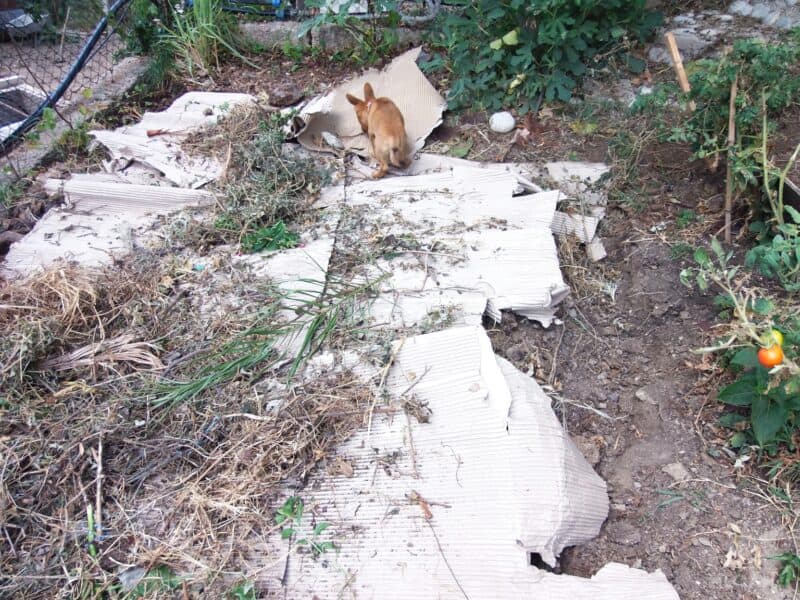
Let’s take a look at what zones 3 through 10 have in common and what is different. You will see that most of your fall preparations the same for all zones. The difference is the length of your growing season. The growing season and temperature will also determine what plants to select.
Zone 10
Lowest average temperature 30 degrees F to 40 degrees F or -1.1 degrees C to 4.4 degrees C.
Please refer to the link below to show your first and last frost times. This is the easiest one I have found and is pretty accurate taking climate change into consideration. Knowing these times is a critical part of having a successful garden.
Zone 10 is the best zone for growing because you can get away with growing all year long. All you need to know is what to plant and when. When it comes to grooming your garden in zone 10, there is not much difference in any of the seasons except when it comes to pruning your trees and shrubs.
If your permaculture garden is preforming as it supposed to, the effort should be minimum and mostly just fun.
You have probably planted annuals like: onions, lettuce, peas, beans, carrots in the early spring months of March and April then your tomatoes, peppers, melons, cucumbers and corn in May to June and have been harvesting them up into late July or even longer. But now that these vegetables are not producing much anymore, it is time to focus on planting for the fall and winter.
The greatest thing about zone 10 is that you can grow all year long as the chance of frost is unlikely. You only need to do minimal preparation for frost in this zone and usually only in December or January.
We will get into the various preparation and maintenance tasks you will want to do later on. First, let’s get our seeds or seedlings into the garden.
Best fall vegetables, to plant between September and October:
| Beets | Kale |
| Broccoli | Peas |
| Brussels sprouts | Spinach |
| Cabbage | Winter squash |
| Carrots | Cauliflower |
These are a few examples of the hardiest plants to grown in zones 10 for winter, there are many more to choose from. Most of your root vegetables will grow great in the winter as well.
Keep in mind, you can grow these all in the spring as well but the taste and yields might not be as good. The reason being is these plants like it a bit colder.
Now, how to prepare the garden for planting winter crops? The process is not much different than what you would do for the spring vegetables. The only difference is that you will remove the finished spring vegetable plants to the compost, or you can just add them to the mulch that will go on top of your winter garden.
It is important also to observe any of the vegetables that were not healthy or just did not perform over the summer. Check these for signs of blight or infestation.
This will give you vital information for next spring. You might not want to plant under-performers again, or might have to study what affected your plants and find a cure for next year.
Some gardeners and permaculturists recommend taking out any plants that where sick, and burning them to prevent any spread. However, if they look toxic, you can add them to the compost. The compost when functioning properly will kill any unhealthy bacteria or infestation.
Fall garden prep tasks for Zone 10:
- Remove all the annual plants that have been harvested throughout the summer.
- Remove any invasive weeds.
- Add these to your mulch or compost.
- If you have fowl like chickens or ducks, fence them in over your planting area for a week before continuing. They will do all the work for you.
- Lift any compacted soil by just using a pitchfork to only loosen the soil, no need to turn it.
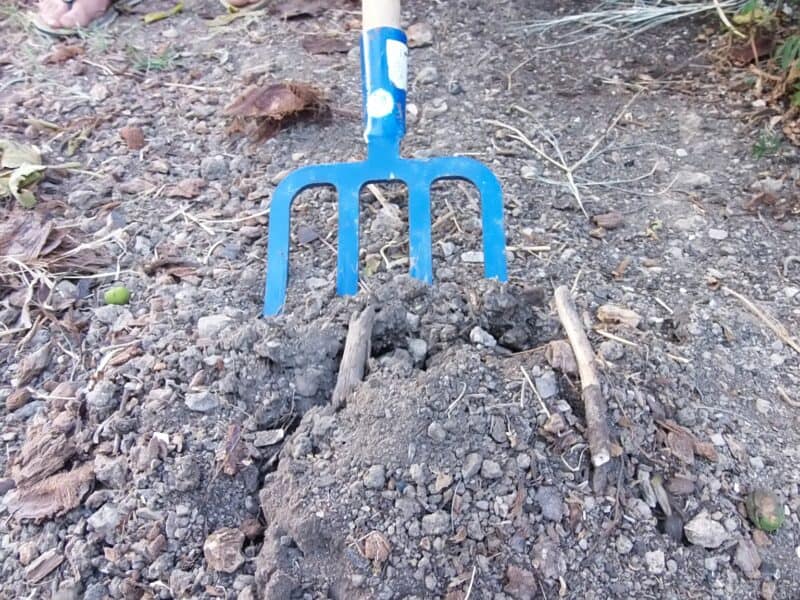
- Put in the compost that you have been preparing all summer, or add any manure you have. This picture is aged goat manure. Just spread over the top.
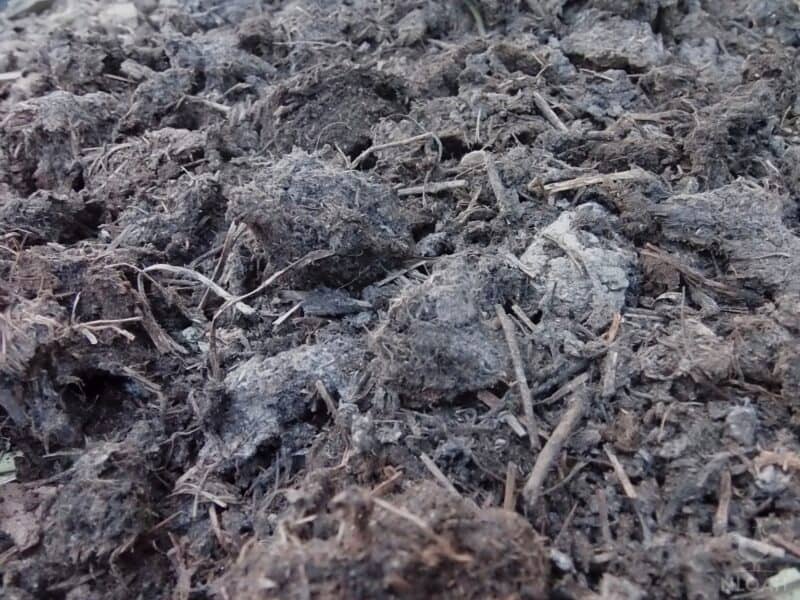
- Add more mulch.
- Trim any of your shrubs or fruit trees and perennials back to where they are producing the correct amount of shade. This is best done when the temperature is cooler.
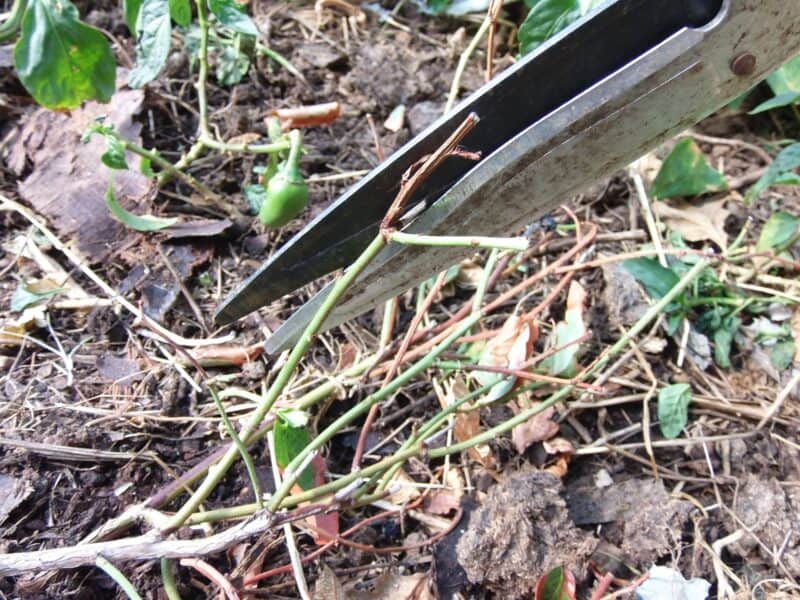
- Repair any swale or trench work you have for water flow. This is the best time, as you have less foliage and can see your swales much better.
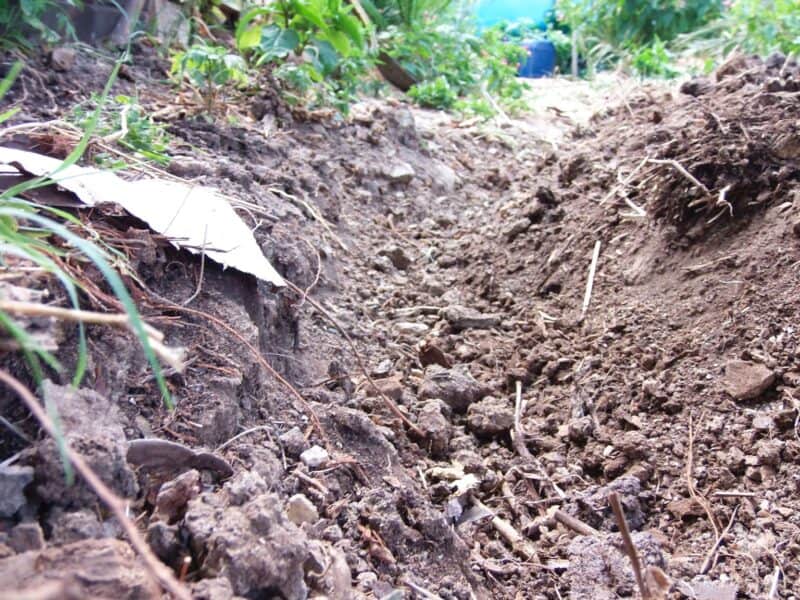
- Repair any edge issues like drainage, or maybe some holes in the fence.
- Water catchment. Often not mentioned in preparing for the fall. This is the time of the year you want to increase, or just maintain your rainwater catchment system. In zone ten most of your rainfall will come in the winter. This is your chance to make sure your water access ways are clean, if your tanks are depleted, drain them and clean out the sediment. Repair any leaks, add filters. In general, now is the time to make improvements.
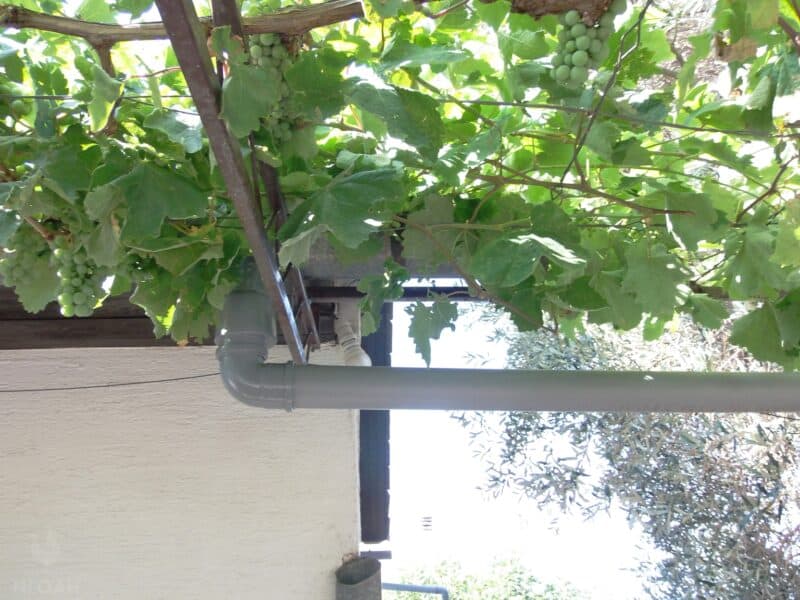
A few more things to remember: always follow the guidelines on the back of your seed package as a good rule of thumb for planting times and sun vs. shade recommendations.
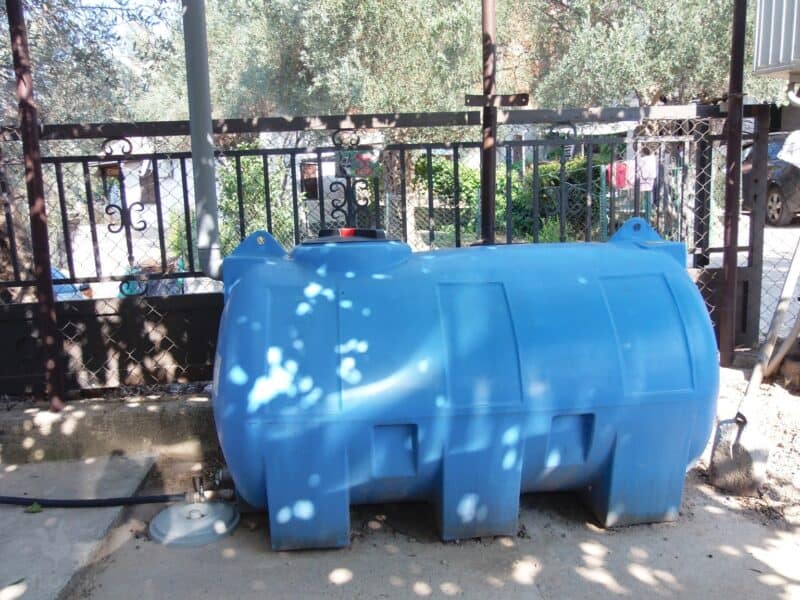
The other thing is, be careful when you water your plants, the best time to water is the early morning. This prevents quick evaporation. If you water in the evening, then the water may stay on the leaves allowing fungus to propagate.
Zones 5 to 9
We can include our fall preparation together for these zones as they will all freeze. Although zone 9 will give you a few more options as you might have in zone 10, you only must take some extra care in the winter to protect your plants from freezing.
These times are critical to know, if you plan on growing, as it gets colder. As you get closer to the frost dates, it is important to start to cover your vegetables at night. This will allow you to continue to grow things like tomatoes, peppers, eggplants and lettuce for longer.
You will want to get started in preparing for winter at the end of September or early October the latest. You don’t want to be caught off guard by the first snowfall.
Most of your preparation will be consistent with zone 10, as these are just practical gardening rules. The different things you will have to do in order to prepare for a colder winter are:
- Prepare the soil for spring. This will save you a lot of work in the spring. A gardener feeds the plants, a permaculturists feeds the soil. The soil is the most critical part of your garden, so it needs some attention. In these climate zones you will not be planting more vegetables, so it’s about soil care and preparing your trees, shrubs and perennials.
- Remove all old vegetables from your garden as well as invasive weeds.
- Lift any compacted areas with your pitch fork, to aerate your soil.
- Add whatever processed compost you have after the summer. This is also a good time to add any manure you can find or already have, with cow, rabbit, chicken being the best and can be put on fresh. Horse, sheep and goat is great, but should be aged for a season for the best result.
- Cover this with a thick mulch of whatever you have, wood chips, sawdust, grass clippings, straw or hay. Get this as thick as you can, it will keep those microbes working in the soil much longer as it gets cold. If you don’t have much mulch, put a layer of thick newspapers or cardboard it on top of your compost and manure, then a thin layer of mulch. Soak down the cardboard, then comes your mulch.
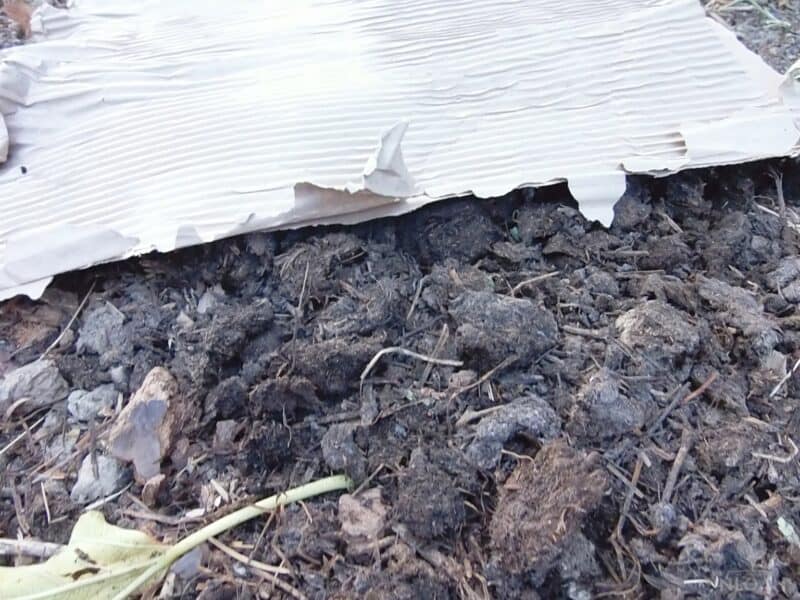
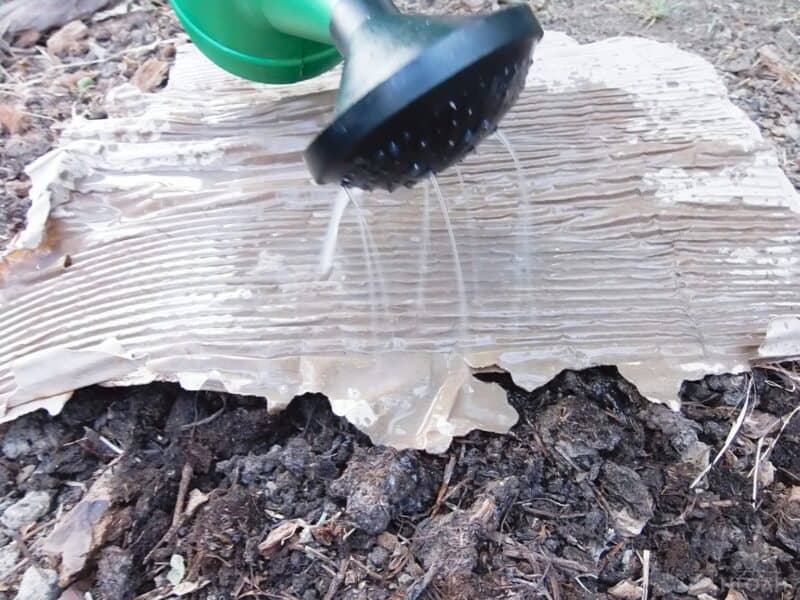
- Thoroughly soak down all your mulch. Your microbes need the moisture to do good work. Mulch on top of the cardboard and water again:
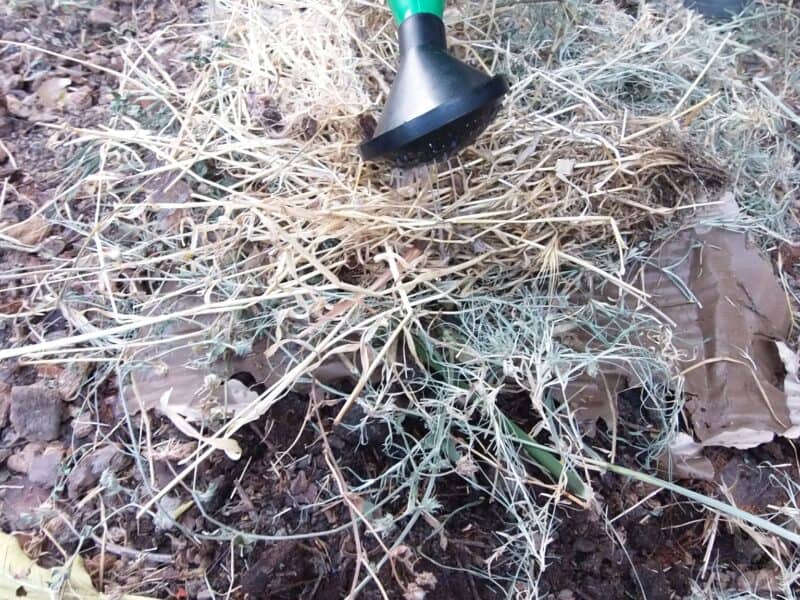
Trees, shrubs and perennials. (All zones 5 to 10)
The fall is the best time of the year to groom or prune your trees, shrubs and perennials. Not only will this save you time in the spring, but it will ensure you plants survival in the event of a very cold winter.
- Prune back any overhanging branches of your large trees that might be providing too much shade on your growing area. You might have some branches encroaching on your house and rain gutters or catchment system. They might even be intruding on your neighbors, and we need to keep them friendly. Don’t be afraid to be aggressive when pruning if the tree is healthy it will come back with gusto. Make sure to do some researchon the particular type of tree you are pruning, this will help you to learn the best places on your tree to make the cuts.
- Prune your shrubs. Bushes like elderberry, raspberry, blackberry, lilac and rosebush. These you will want to aggressively prune back. You can prune all of these back right down to just the stock. This not only helps them through a cold winter it will increase their growth next spring.
- Protect your vegetables from the first frosts. You might still have tomatoes and few other kitchen vegetables growing into the fall. You just want to make sure to have some plastic or even cloth sheeting to cover these on the cold nights. This will prevent frost bite, and supply you with fruit a bit longer into the season.
- Protect your small trees. You might have just planted some small fruit trees or berry bushes. You will have to protect these young ones from the cold, if temperatures get to low they will die. To do this, surround the base of them with a heavy mulch, some burlap sack or even some old carpet. Make sure this is tight around the trunk. This should be done sometime after the first frost but before it starts to really freeze up. Make sure you give all your trees and shrubs a good watering before covering them, just as you did your soil. Another trick, during extreme cold is to surround the base of all your trees with thick snow. This will insulate them, getting them through the dangerous cold temperatures.
- The same practice for your perennial plants. If you are getting extreme temperatures then cover them up with whatever cloth material or mulch that you have. Perennial plants are pretty tough if they are native to your zone, and will come back every year, unless there is some extreme anomaly in the weather. Give them a good watering before the cold sets in and you will see them in the spring.
- Use the chop and drop method for pruning smaller branches and bushes. Unless there is a disease, this just adds more nitrogenand mulch to the soil.
- The fall is the best time to add new trees or shrubs. The soil is still warm, so they have a chance to develop a good root system, they will need to harvest water in the heat of next summer. Make sure to water frequently as the fall winds are sure to dry them quickly.
- Water catchment. For zones 5 to 9 you will want to do all the same things for your rainwater system as those in zone 10. In addition you must consider when it freezes. If you don’t have some type of water heating system in place, then you are going to have to drain your system or risk cracks due to ice, or have a lot of work in the spring replacing pipes.
Materials to have on hand:
- Compost
- Mulch
- Cloth like burlap or old carpet
- Plastic sheeting
- Shovel, is always good to have on hand
These are a few of the things you want to keep in the front of your garden shed, so you can quickly grab them. Make sure that anything you use for water like hoses and buckets are well drained or you will be replacing it after it freezes and splits.
If you have chickensor ducksfor the first time, make sure you have plenty of insulation to surround their coup with, hay or straw bales. You might even want to have some heat lamps on hand for when it turns really cold.
Chickens are pretty durable, and provide their own warmth, but they also have limitations. They are as valuable a resource as any other food you are growing, take care of them and they will continue to supply you with food.
A Few Tips for Zones 3 and 4
If you are living in either of these zones, then all your garden fall preparation is the same. What you will want to do differently because of a shorter growing season, is to start your seeds indoors. Rather than just planting seeds directly into the ground, give them a head start.
Plant your seeds in small pots on a sunny window sill about 6 weeks before the last frost, they will grow much quicker and give you a good yield prior to the first frost.
Follow these few simple steps, and you can look forward to turning that flat piece of dirt into your very own food forest. Happy permaculture!


Dirk is Canadian permaculture designer with a certificate from Tagari farms, studying under the tutelage of the legends and founders of permaculture Bill Mollison and Geoff Lawton. Dirk has been doing permaculture for more than 20 years, initiating and managing projects in Cambodia, Madagascar, Montenegro, and Vietnam. He’s been helping people use permaculture techniques in growing their own food, and in leading more sustainable lives across the world.

No heat source for poultry. If the power goes out then because the birds haven’t built up their winter down under coats they will surely die from the drastic drop in temperatures. The other reason is the dander that builds up in the air of the coop settles on the heating element/bulb and this will ignite causing a fire. The other fire starter is if the birds flutter/fly about in the coop they can bump into the heating unit and cause the bulb to shatter and fall into the bedding below. This will smolder and ignite, causing a fire.
Just a few reasons why using heating in coops is dangerous. It is the leading cause of fires in coops.
Caution: do so at your own risk. It is ill-advised, however.